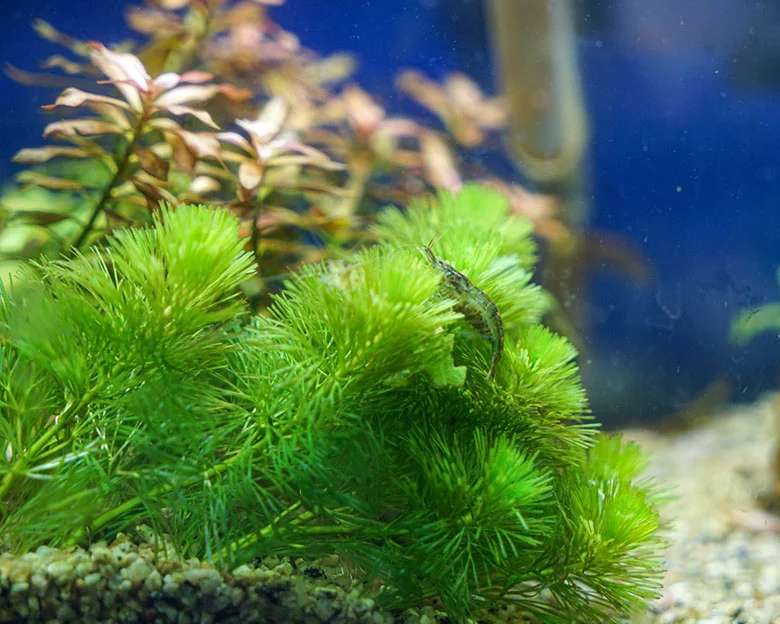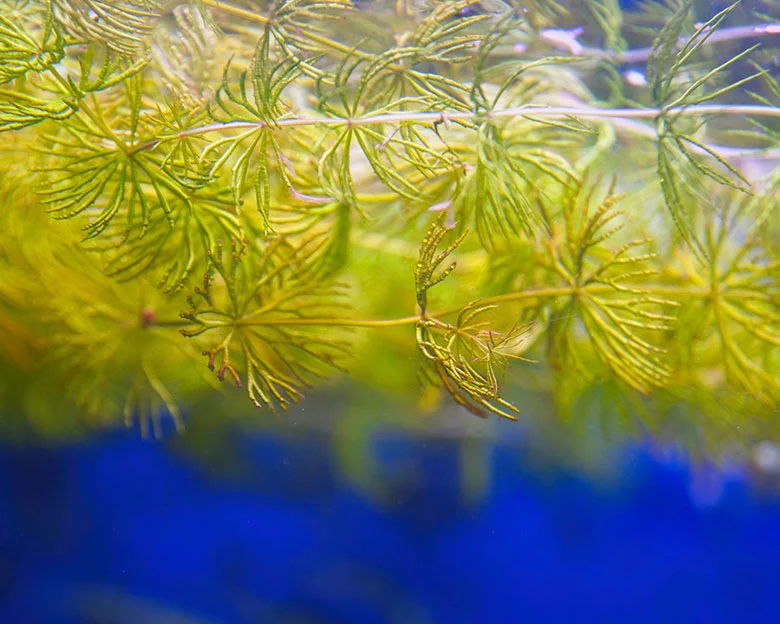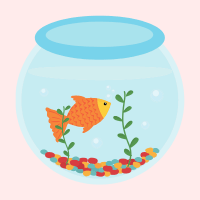If you’re a beginner aquarist looking for a versatile and adaptable freshwater plant, hornwort care may be the perfect choice for you. This fast-growing plant is easy to care for and has a variety of uses in aquariums, making it an ideal addition to any tank.
Hornwort is not only aesthetically pleasing but also helps reduce nitrate levels in your aquarium, providing a healthier environment for your fish and other aquatic creatures. Additionally, it can provide hiding places for small shrimp and fish, which can help to reduce stress and improve their overall well-being.
In this article, we will provide expert tips and advice on how to care for hornwort, including ideal water conditions, propagation methods, and potential drawbacks. Whether you’re a seasoned aquarist or just starting out, hornwort is a great choice for any aquarium.
Key Takeaways
- Hornwort is a fast-growing freshwater plant that doesn’t require roots and absorbs nutrients directly from the water column through its stems and leaves.
- It is adaptable to a variety of water conditions and lighting, making it an excellent option for both seasoned and new aquarists.
- Hornwort can be used as a decorative plant in aquariums, helps keep water cleaner by reducing nitrate levels, provides hiding places for tiny baby shrimp and fish, and helps control algae in different ways.
- Hornwort is easy to propagate, easy to maintain once established, and doesn’t require fertilizers or CO2, making it a great option for beginners. However, it sheds like crazy, can be messy, and isn’t great for aquascaping.
Description and Classification

You’ll be interested to know that hornwort, also known as Ceratophyllum demersum, belongs to the family Ceratophyllaceae in the kingdom Plantae. This freshwater plant is commonly found in ponds, lakes, and slow-moving streams, where it grows in large bunches in areas of low currents.
Its unique morphology makes it stand out from other plants, as it doesn’t grow roots and instead absorbs nutrients directly from the water column through its stems and leaves. Hornwort’s habitat is not limited to a specific region or country, as it can grow in waterways all over the world.
Its taxonomy and morphology make it a fascinating plant for aquarists, as it’s a fast-growing plant with a growth rate of fast and is ideal for background tank placement. Its adaptability to a variety of water conditions and lighting makes it a great option for both seasoned and new aquarists.
Growth and Adaptability
With its fast growth rate and ability to adapt to a variety of water conditions and lighting, hornwort is a perfect plant for beginner aquariums. This freshwater plant grows quickly and can reach lengths of up to 15 feet, making it an ideal choice for background tank placement.
Additionally, hornwort is adaptable to a variety of water conditions and lighting, making it a versatile and low-maintenance option for both seasoned and new aquarists.
Hornwort’s ability to adapt to different tank setups makes it an excellent choice for a variety of aquariums. Whether you have a low-light tank or a high-tech setup with CO2 injection, hornwort can thrive.
This plant is also versatile in terms of placement, as it can be left to float freely in the water column, weighed down with decor or plant anchors, or planted into the substrate. With its numerous benefits, hornwort is a must-have for any aquarium enthusiast looking for an easy-to-care-for and visually appealing plant.
Uses in Aquariums
If you’re looking to add a decorative and functional element to your aquarium, consider the various uses of hornwort. This fast-growing plant is not only visually appealing but also provides a multitude of benefits for your aquatic inhabitants.
Hornwort can be placed in various ways, such as being weighed down with decor, planted in the substrate, or allowed to float freely in the water column. One of the greatest benefits of hornwort is the hiding place it provides for tiny baby shrimp and fish.
The plant can also help control algae in two different ways, by out competing it for nutrients and by producing allelopathic compounds that inhibit its growth. Additionally, hornwort can help keep the water cleaner in between water changes by reducing nitrate levels.
Its versatile and adaptive nature makes it an excellent option for both seasoned and new aquarists.
Ideal Water Conditions

Maintaining the ideal water conditions for hornwort is crucial for its growth and health. The plant thrives in a temperature range of 60°-80°F (15°-26.7°C) and a pH range of 7.0-8.0. It’s important to ensure that the water temperature and pH levels remain stable, as fluctuations can cause stress and damage to the plant.
In addition to temperature and pH, water hardness and nutrient levels should also be considered. Hornwort is adaptable to a variety of water conditions, but it’s important to keep the water clean and free of excess nutrients. Regular water changes and the use of liquid fertilizers can help maintain the ideal water conditions for hornwort. This ensures that it remains a healthy and vibrant addition to any aquarium.
Propagation and Maintenance
To successfully propagate and maintain hornwort in your aquarium, you’ll need to put in a little effort, but the reward of a beautiful and healthy plant is well worth it.
Propagation is easy and straightforward, and there are two cutting techniques that you can use. The first is to cut off the top of the plant, leaving about two inches of stem, and then replant the top in the substrate or let it float. The second technique is to cut off a side shoot and then plant it in the substrate or attach it to decor using a fishing line. Both techniques are effective, and the cuttings will quickly grow roots and start to develop into mature plants.
In terms of maintenance, hornwort is a fast-growing plant that requires frequent trimming to keep it under control. Trim back the plant once or twice a month to prevent it from taking over the aquarium. You can discard the trimmed sections or keep them in the tank to grow into new plants.
Fertilization frequency will depend on the nutrient levels in your tank, but as a general rule, hornwort eats up nutrients quickly, so liquid fertilizers may be necessary. Keep an eye out for signs of nutrient deficiencies in other plants if the hornwort is taking up all the nutrients.
With a little bit of effort, you can enjoy the benefits of a healthy and beautiful hornwort plant in your aquarium.
CO2 and Nutrient Requirements
You can enhance the growth of your hornwort plant by providing it with CO2 and regular liquid fertilizers to meet its nutrient requirements. CO2 supplementation increases the rate of photosynthesis, which in turn promotes plant growth.
You can supply CO2 to your hornwort plant in several ways, including using a CO2 injection system or adding CO2 liquid to the aquarium water. The amount of CO2 required will depend on the size of your aquarium and the number of plants you have.
Proper nutrient management techniques are also essential for the growth and health of your hornwort plant. As a fast-growing plant, hornwort absorbs nutrients quickly from the water column. If insufficient nutrients are unavailable, the plant may become stunted or discolored.
Liquid fertilizers can help supplement the nutrients in the water, ensuring that your hornwort plant has everything it needs to thrive. It’s important to follow the instructions on the fertilizer package and monitor the levels of nutrients in the water to prevent over-fertilization, which can lead to algae growth and other issues.
Drawbacks and Considerations
Now that you know about the CO2 and nutrient requirements for hornwort care, it’s important to consider the drawbacks and other considerations before adding this plant to your aquarium. While hornwort is a versatile and adaptive plant that is easy to care for, it comes with its own challenges.
Firstly, the needles of hornwort are tough and pointy, which may not appeal to most fish. Additionally, hornwort sheds like crazy and can be messy, so a regular cleaning routine is necessary. However, despite these drawbacks, hornwort can still be a great addition to your aquarium.
Here are a few considerations to keep in mind when caring for hornwort:
- Fish compatibility: While hornwort does provide an excellent hiding place for tiny baby shrimp and fish, it may not be the best option for all types of fish. Some fish may not enjoy the texture of the needles or may not be compatible with the nutrient levels that hornwort absorbs from the water column.
- Cleaning routine: Since hornwort sheds needles and can make a mess, it’s important to incorporate a regular cleaning routine into your aquarium maintenance schedule. This may include removing excess needles from the water and substrate or trimming back the plant to prevent it from taking over.
- Aquascaping: While hornwort may not be great for intricate aquascaping designs, it can still be used to create a natural and organic look in your aquarium. Consider adding other plants or decor to balance out the wild growth of hornwort and create a more visually appealing environment.
Interesting Facts
Did you know that hornwort can grow up to 15 feet long and doesn’t have roots? It’s an interesting fact about this versatile plant that can adapt to a variety of water conditions and lighting. In addition to its adaptability, hornwort provides an excellent hiding place for tiny baby shrimp and fish. Ornamental shrimp love to hang out in bunches of hornwort, feeding on the biofilm that grows on it. This makes it a great addition to any shrimp tank.
Hornwort can be found in waterways all over the world, from North America to Europe and Asia. It is a fast-growing plant that can help control algae in two different ways. First, it absorbs excess nutrients from the water column, such as nitrate, which can cause algae blooms. Second, it provides competition for light and nutrients with algae, which can help keep algae growth under control. With its global distribution and benefits for shrimp, hornwort is an excellent choice for beginner aquarists looking to add some greenery to their tanks.
| Benefits for Shrimp | Global Distribution | Other Interesting Facts |
|---|---|---|
| Provides hiding place | Found in North America, Europe, Asia | Can grow hairlike rhizoids |
| Feeds on biofilm | Helps control algae growth | Can be trimmed back to prevent overgrowth |
| Excellent for shrimp tanks | Can be planted in main display tank or refugium | Can shed needles and make a mess |
| Versatile and adaptive | Ideal for background tank placement |
Frequently Asked Questions
Can Hornwort Be Used In A Saltwater Aquarium?
Hornwort in Saltwater: Pros and Cons. While adaptable to a variety of water conditions, Hornwort is best suited for freshwater environments. It cannot thrive in saltwater as it lacks the necessary adaptations to survive in this type of environment.
How Long Does It Take For Hornwort To Grow To Its Full Length?
Hornwort growth rate can vary depending on the conditions it’s in, but it can grow up to 15 feet long. Pruning techniques involve trimming back once or twice a month to prevent it from taking over the aquarium.
Can Hornwort Survive In Low Light Conditions?
Hornwort can survive in low light conditions but become leggy and lose its bushy appearance. Benefits of Hornwort include reducing nitrate levels, providing hiding places for baby shrimp and fish, and controlling algae. Tips for propagating Hornwort include cutting off a piece of stem and burying it in gravel or weighing it down with decor.
Can Hornwort Be Grown Emersed?
Yes, hornwort can be grown emersed. This can benefit hornwort propagation by allowing the plant to grow faster and produce more shoots. Growing hornwort emersed also helps to prevent shedding and provides a unique aesthetic to aquariums.
Can Hornwort Be Used In A Paludarium Setup?
Hornwort’s Paludarium compatibility is excellent due to its adaptability to a wide range of water conditions and lighting. It can be creatively used for aquascaping ideas, providing hiding places for shrimp and fish while reducing nitrate levels.
Take Action and Transform Your Aquarium with Hornwort!
You’ve successfully learned how to care for hornwort – the perfect plant for beginner aquariums. This versatile and adaptable freshwater plant has a variety of uses. It can provide a decorative element, reduce nitrate levels, and provide shelter for small aquatic creatures.
Just like hornwort, you too can adapt to new environments and thrive with the right care and attention. With proper maintenance, you can watch your hornwort grow and flourish. Similarly, with determination and hard work, you can achieve success in your own life.
Remember always to provide the ideal water conditions for your hornwort. Propagate and maintain it regularly, and be aware of any potential drawbacks. By doing so, you can enjoy this amazing plant’s benefits for years.
So go ahead and add hornwort to your aquarium, and watch as your aquatic world comes to life!

